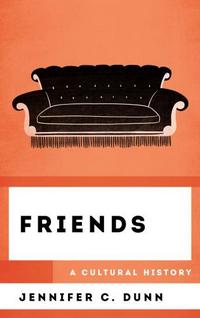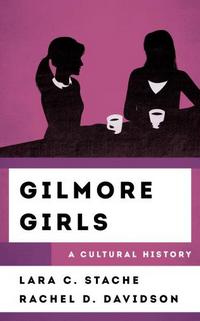 |
Friends: A Cultural Historyby Jennifer C. Dunn eARC, 288 pg. Read: November 15-December 3, 2019 |

I’ve only read one other book in this series (Gilmore Girls: A Cultural History), which led to me expecting a few things from this book—most of which I didn’t get (which is both a positive and a negative comment). I’m going to try not to spend too much time comparing the two books because it seems unfair—but it’s inevitable, so . . .
When I requested that Gilmore Girls book on Netgalley, I noticed the publisher had a similar title about Friends available—and who doesn’t like Friends? So, I requested that one, too—really diving into The Cultural History of Television. Granted, Dunn has more episodes to work from, but she does a better job of getting examples from all over the series—using different episodes/lines/characters to make related points rather than grabbing the same episode/line/character over and over and over again. One of the biggest strengths of the book is the depth of examples she musters for almost every point, reading this book is almost like binge-watching the entire series.
She begins with a chapter describing the success of the show, its place in the history of sitcoms—building on what had come before and shaping its successors. Then she moves on to looking at the impact of the show, its characters, and its actors on mainstream American pop culture—I do think she tried to make a little more hay than was warranted with some of the intertextual links she made in this chapter, but it came across as a quirk rather than a flaw. The third chapter discussed the way that the show replaced a biological family for a found family of friends as the core relationships for the characters. I really appreciated this section of the book and it gave me high hopes for the rest.
The third section of the book explores the legacy of Friends on American—and global—pop culture, as seen in fashion, music, memes, the way we talk (e.g., try to tell someone to pivot without invoking Ross trying to get his couch up the stairs), and the actors’ future roles and shows. This part wasn’t as strong as the first part of the book, but it was entertaining and an interesting way to think about the show. Dunn follows that with her list of the best 25 episodes, including an episode synopsis and a few sentences describing why that episode made the list. Fans will quibble over this list (for example, I think she got 15-18 of them right, and I can’t understand why she picked the others)—but I can’t imagine any fan not enjoying reading it.
The thing that makes me reticent to heartily recommend the book is the second section of the book, which includes the chapters: “Friends Happy Not Doing Too Much,” “Friends Happy Not Thinking Too Much,” “Thin, White, Upper-Middle-Class Friends,” and “Stereotypes, Sexuality, and Friend-ly Tensions.” Dunn states that this section “interrogates cultural identities represented on Friends.” There is a lot of interesting material presented in this section—whether you ultimately agree with her analysis or not—and most of it is well-presented. However, it’s a pretty problematic section. First, it assumes the readers will share her Progressive views (or at least hold ones close to hers) and that 2019 Progressive positions ought to provide the basis for evaluating the shows portrayal of characters/issues/themes, rather than the standards of the time the episodes were produced.
I’m not going to get into a point-by-point evaluation of these chapters, that’s not what this post is about, I’m just looking at this broadly. For example, Dunn begins her chapter on the anti-intellectual bent of some of the humor by pointing to the re-election of George W. Bush as president as one bit of evidence to the rise of anti-intellectualism in the era. I’m not sure I see the wisdom in insulting conservatives, Republicans, or moderates who voted for Bush and who enjoy discussions of a beloved sitcom and might be reading the book.
Yes, the writers couldn’t have made many of the jokes they did if the show was being produced now—but I’m not convinced that means they shouldn’t have then. At one point (at least) Dunn does concede that 2019 standards are different from those of that era, but it doesn’t stop her from criticizing aspects of the show for being products of their time. It seemed to me that at any point where she judged the show’s treatment of something in these chapters, she condemned it rather than look for an opportunity to be charitable. Now, there is a certain amount of intellectual stimulation and pleasure to be found in arguing with a book—and my notes indicate that I did a lot of that during these chapters—but at a certain point I started wondering why someone who clearly disapproved of so much of the show would watch it as much as she clearly has. To me, that detracts from the overall experience.
I’m not trying to suggest that Dunn’s criticisms are baseless, or that I disagree with everything she said in this section. I just think she comes across as unexpectedly antagonistic to the show and doesn’t do herself any favors with many of her readers.
It’s annoying that I had to spend that much time attempting to explain my problems with that section—it’s dicey so I tried to do a good job of that, but now that’s taken the majority of my space here. By importance, it should be about 1/3 of what I say about the book (maybe 40%). But to expand my comments on the rest would render this too long to read (and write, honestly).
I had one other stumbling block with the book—but this is more stylistic and is easily forgettable. You’ve probably read or heard the line: “Explaining a joke is like dissecting a frog. You understand it better but the frog dies in the process.” I’ve seen it variously attributed, but E. B. White seems the most likely candidate. It’s a trite observation by now, but mostly because it’s true. Dunn explains too many jokes for little profit—generally, they’re jokes that don’t require an explanation in the first place (especially for fans who know the joke, but I think it’s true regardless) and her explanations frequently border on condescending. White (or Twain or whoever) would probably have been willing to say “Explaining a joke or a meme” had they been aware of the concept. Neither one of these things is a major issue, but it grates on the nerves and makes the experience less positive
Ultimately, while I enjoyed the Gilmore Girls entry more, I think this book makes the series seem more promising and will likely lead me to read more of it. On the whole, this was a very enjoyable read and die-hard fans will easily dive into most of the book and relish the experience. And even on those points, a reader will disagree with her on, they’ll enjoy ransacking their memories for counter-arguments. Really, this is an excuse to think deeply about a favorite show for however long it takes you to read 300 pages, not much wrong with that.

Disclaimer: I received this eARC from Rowman & Littlefield Publishers via NetGalley in exchange for this post — thanks to both for this opportunity.
This post contains an affiliate link. If you purchase from it, I will get a small commission at no additional cost to you. As always, opinions are my own.
![]()




